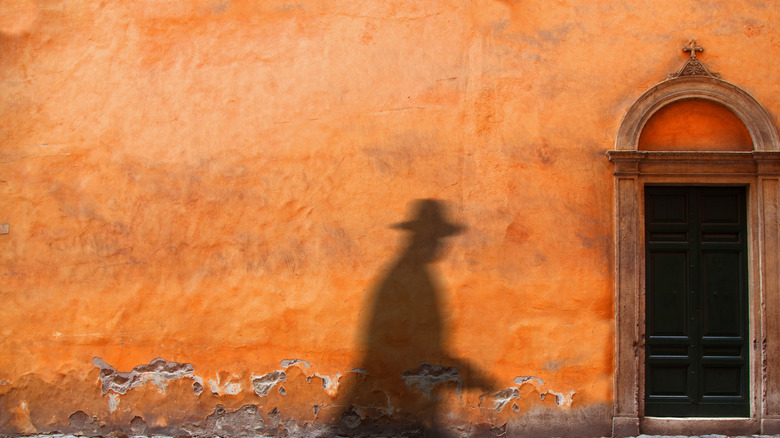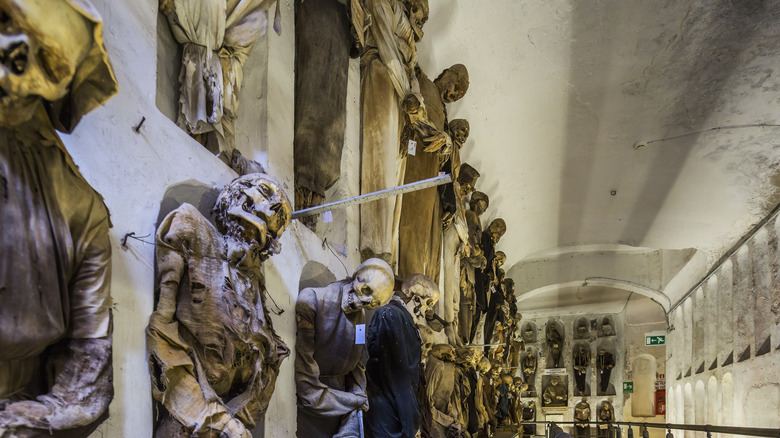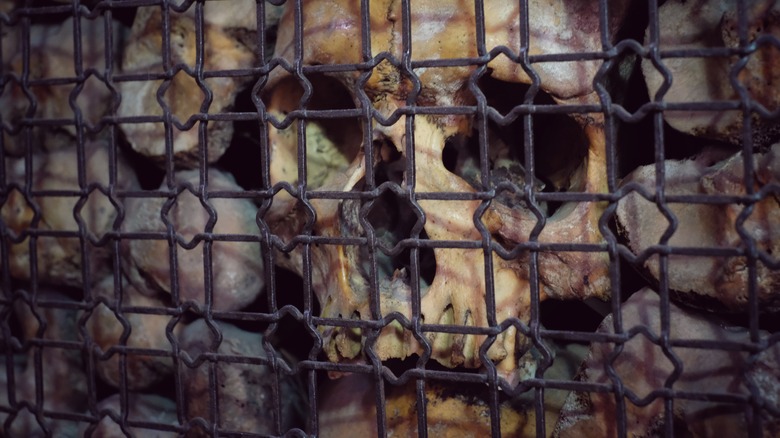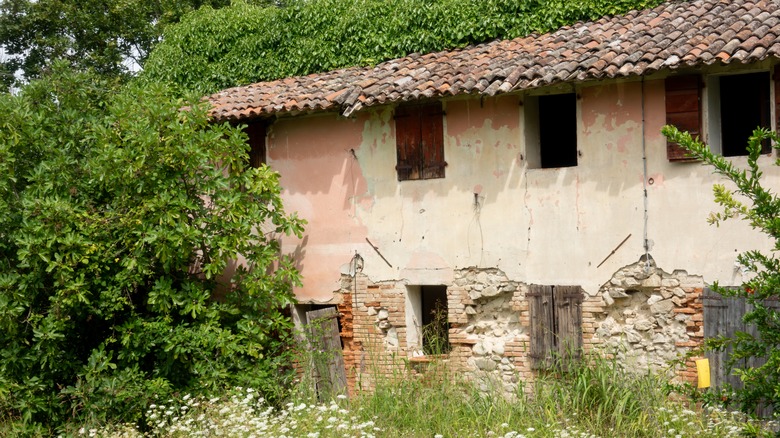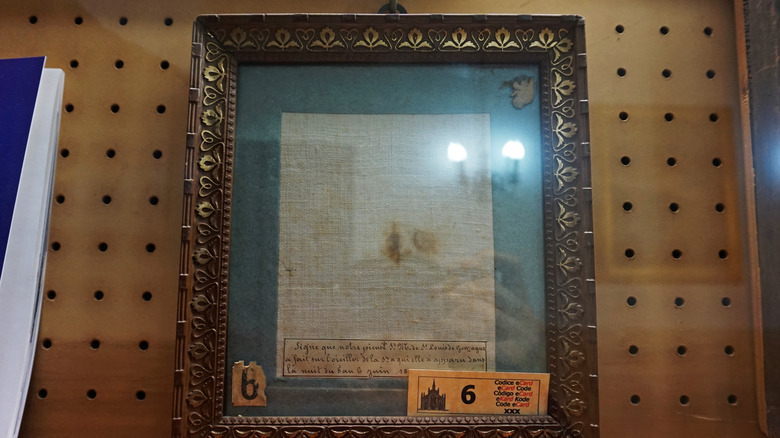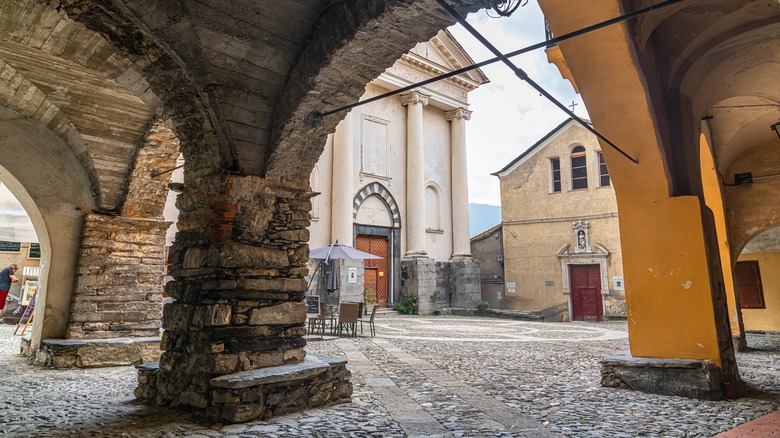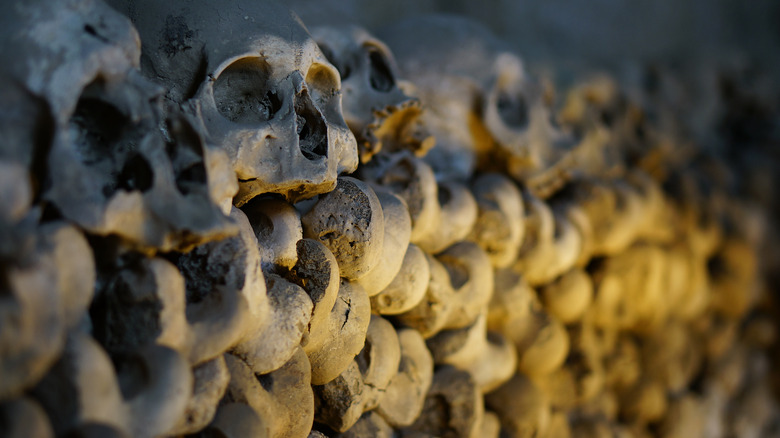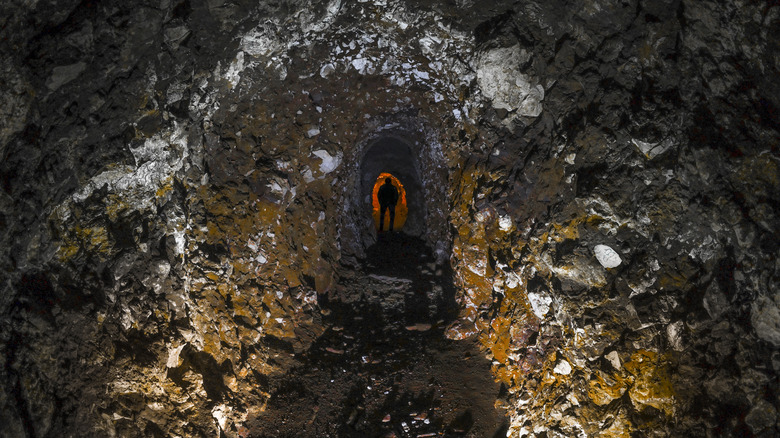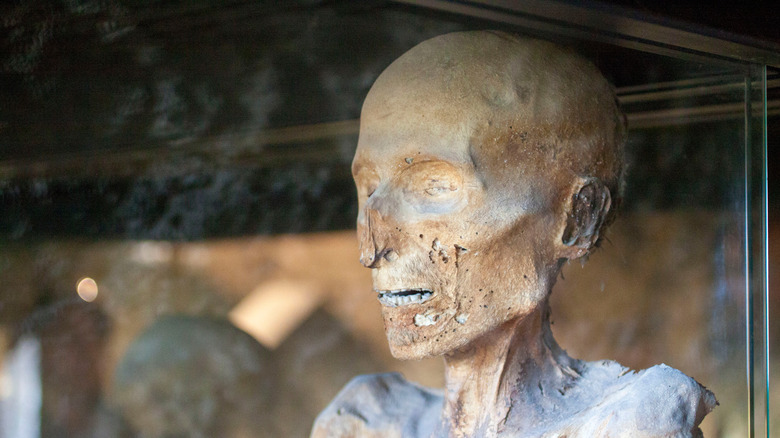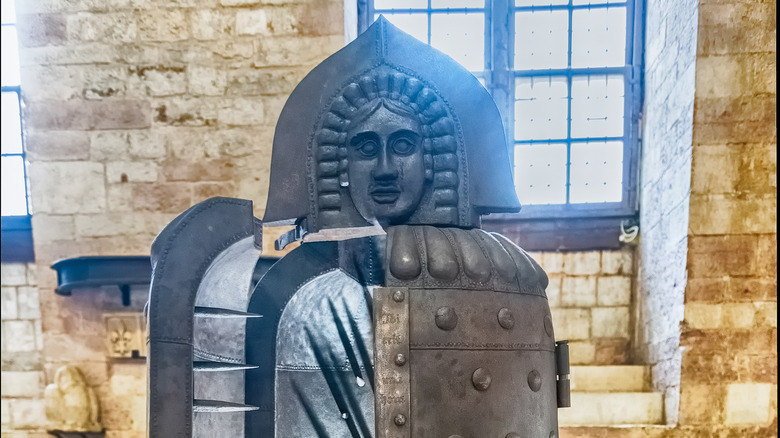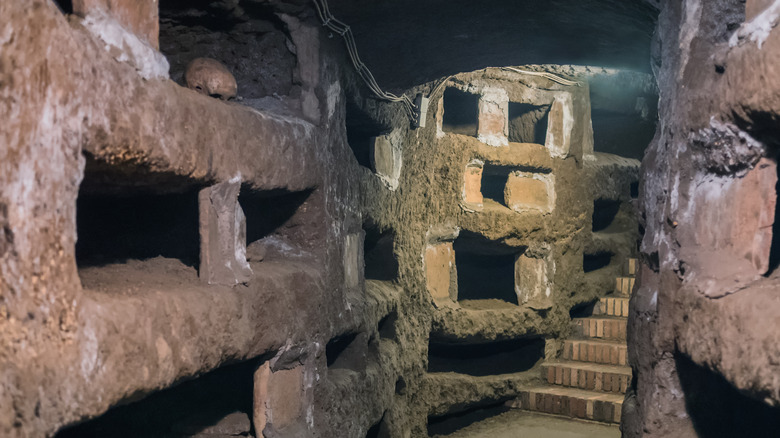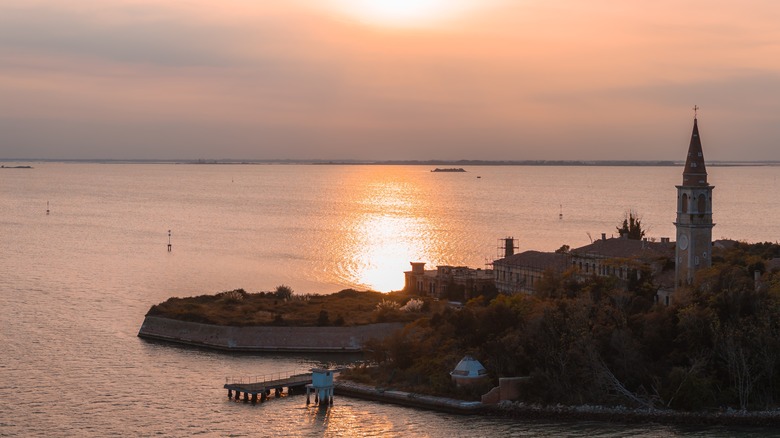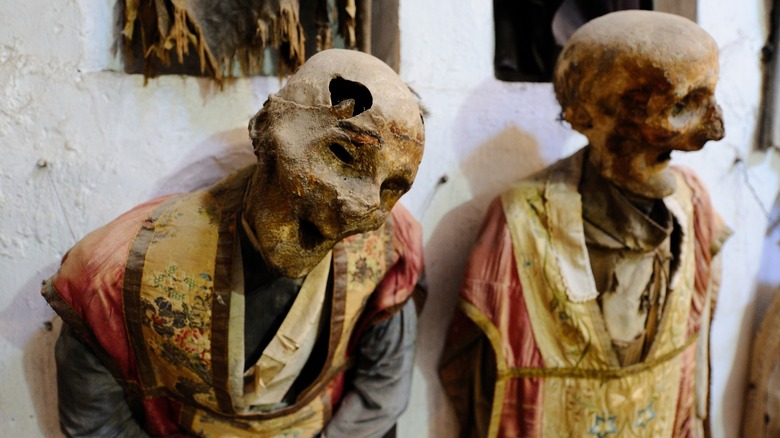The Most Haunted Destinations In All Of Italy, According To Research
Italy is one of Europe's top vacation destinations. Whether it's to take in the stunning fall foliage views, or to swim at one of the many amazing beaches along the Amalfi Coast, there are no shortage of reasons to visit this fantastic Mediterranean country. However, during spooky season, there's also another reason to visit Italy.
For those who love ghosts and other haunted tales, take note. Throughout Italy, you can find a number of different haunted destinations. An island in the Venetian lagoon that was once used to quarantine the sick? A museum filled with mummified corpses? A remote villa that is said to be home to a terrifying witch? All are real places you can visit in Italy.
Through our own historical research and Italian lore, we've pinpointed what we feel are the most haunted places in all of Italy. Note, there is a heavy religious presence on this list. As one of the oldest and most predominant Catholic countries in the world, many of Italy's haunted destinations have a connection with the Catholic Church. There are secular locations as well, but don't be surprised to see that most of these 12 haunted, spine-chilling destinations have religious associations.
The Capuchin Catacombs, Palermo
Aboveground, Palermo is a charming, historic metropolitan destination. As the capital of Sicily, and perhaps the best food destination in all of Italy, Palermo is a hotbed for tourists seeking the very best of Sicilian food, history, and nightlife. Yet, it is beneath the city where you will find its most haunted spot.
Literally buried under the streets of Palermo is the Catacombe Frati Cappuccini (The Capuchin Catacombs). The catacombs are a vast crypt, a network of graves built beneath a Capuchin convent in Palermo. The 17th-century friars there began mummifying their fellow brothers, and placing their corpses in the crypt below the chapel. This practice continued until the 1920s, and included several Sicilian noblemen and two-year-old Rosalia Lombardo, considered to be the most beautiful mummy in the world.
If it weren't creepy enough to be walking around a vast tomb of mummified corpses, it gets even creepier when you realize the fact that nearly all of them are clothed and, in many cases, arranged as if in conversation with one another. This gives visitors the feeling of the place being somewhat haunted. It's very easy to feel as if those empty eye sockets are actually following you as you move about the tomb.
Chapel of the Dead, Otranto
The southern Italian region of Puglia, known colloquially as "The Heel of the Boot," juts out into the Adriatic as its own peninsula. Despite being one of Italy's forgotten regions, Puglia is seeing a resurgence in popularity among tourists. While most come for the sand, warm waters, and excellent food, haunted destination seekers will find in Puglia one of the most haunted places in all of Italy.
The Chapel of the Dead, also known as the Chapel of the Martyrs — or formally as the Cathedral of Santa Maria Annunziata — in Otranto is something of a Catholic pilgrimage site. It was here during the 15th century that invading Turkish Ottomans beheaded 813 Catholic martyrs, putting their heads on display across Otranto for all to see.
The bodies and heads were eventually stacked and moved to glass cases behind the altar of the church, where they remain on display for curious visitors and pilgrims looking to pay holy homage to the dead. If the skulls and bones weren't creepy enough, the beheading stone where all of the martyrs were killed is still on display, as are several medieval torture chambers beneath the chapel floor.
The Ca'Dario House, Venice
Venice is a uniquely constructed city that draws millions of tourists every year. Despite the fact that this floating metropolis is steadily sinking into the sea, Venice still charms with its lack of motor vehicle traffic, long, twisting alleyways, and romantic bridges. The architecture is something to ogle at too. St. Mark's Square is nothing short of a marvel, as are many of the houses floating in the lagoon. However, there is one house that has garnered a terrifying reputation.
Since its construction in the 1500s, Venice's Ca'Dario house has been the subject of haunted suspicions. For over 500 years, the owners of the house have died under mysterious circumstances. From murder and strange accidents to untimely deaths and disappearances, the "Cursed Palace", as the locals call it, is known throughout the world as Venice's most haunted building.
And this isn't exactly ancient history. In 2002, John Entwistle, bassist for The Who, rented the Villa for a few nights and died a week later of a cocaine overdose, per Visit Venezia and The Guardian. You might think that has nothing to do with the house, and that it's merely coincidence, but still ... it makes you wonder.
Villa Magnoni, Cona
Let us ask you a question: Would you, if given the opportunity and funds, go full "Under the Tuscan Sun" and buy a dilapidated villa in Italy with the intention of restoring it and making it your permanent home? Of course you would. Now, let's add an addendum: What if it was haunted? And not just by ghosts, but by an evil witch.
No doubt some of you would still say "Yes!" but the locals of Cona in Emilia Romania would advise you otherwise. The Villa Magnoni, despite being a perfect candidate for "Tuscan Sun" treatment, is said to be haunted by a witch whose curse makes any visitor to the building hear harrowing screams and other terrifying noises.
She's not known to make regular appearances, however. The last known encounter with her was in 1980 when a group of teenage boys entered the house out of boredom, only to be set upon by the witch. The boys died in the ensuing escape, causing the community to board up the house and deter anyone from entering, or even going near it. Today, its decay and surrounding overgrowth give it the look of a very haunted house indeed.
The Purgatory Museum, Rome
Many who visit Rome do so for the romance of it all. There are so many romantic destinations one can see while visiting The Eternal City. The Museum of the Holy Souls in Purgatory ain't one them. Don't get us wrong, everyone has their own ideas as to what is, and is not, romantic. We'd bet money that visiting a museum dedicated to trapped souls longing to reach eternity is very, very, far down on that list.
This small museum is tucked into the back of the Chiesa del Sacro Cuore del Suffragio, not far from the famous Castel Sant'angelo and its adjoining bridge. The objects of the museum are something of a fascination to visitors, especially Catholics who believe the dead remain in Purgatory until they have atoned for their sins. Several of the items on display are Bibles, items of clothing, or pieces of furniture that appear to have handprints burnt into them by said trapped souls.
The items were collected from other churches, and terrified individuals thinking they'd been visited by relatives stuck in Purgatory. However the handprints came into existence, there is certainly a chilling aura about the museum that will strike even the most skeptical visitor as downright creepy.
The Witches Village, Triora
The small, medieval village of Triora is tucked into the foothills of Liguria, well above the more well-known riviera that includes the stunning scenery and glamorous shopping of Cinque Terre. Triora seems innocent enough, with cobblestone streets and scenic views of the surrounding hillsides. However, this tiny village was home to Italy's version of the Salem Witch Trials.
During the 1500s, around 200 women in Triora were accused of practicing witchcraft. The locals believed that their evil magic had caused a famine to befall the town, along with several other convenient misfortunes. The women were imprisoned, tortured, tried before a town jury, and eventually killed. All without any actual evidence to support their claims.
Today, it is said that the souls of these women still wander the cobbled streets at night. Garnering a fame similar to that of Salem, Massachusetts, Triora holds an annual witches festival that is complete with bone fires in the town square and a traveling theater that recreates some of the events of the witch hunt.
Fontanelle Cemetery, Naples
The city of Naples has seen its fair share of tragedies. From the cholera epidemic of the 1800s to Allied bombing during World War II, Naples is, sadly, no stranger to death. During a period of disease during the 17th century, the city began to run out of room for its dead. That's when the bodies were moved to an ancient cave outside the city walls that had been used as a burial site in the ancient days. It would eventually become known as the Fontanelle Cemetery.
It is estimated that there are some 40,000 skeletons housed in the Fontanelle. The skulls and bones are set in neat piles that line the lower walls of this massive cave. Over the decades of its use, people began to go into the cave and hunt for the skulls of relatives, praying to them for fortunes, and, in some cases, the deaths of other relatives.
This cult was eventually so widespread that the Archbishop of Naples shut down the cemetery in 1969. Today, the Fontanelle is no longer in use as a burial site, but instead is a major Neapolitan tourist attraction. Visitors can walk through the cave, which is almost the size of a cathedral, and see what will likely be the most skeletons they will ever see in their lives. It all lends a very strange atmosphere to the environment.
The Torture Chambers of Narni
Nobody expects ... the Italian Inquisition? While the Spanish Inquisition is one of the most infamous periods of Catholic history — thanks in no small part to a certain Monty Python sketch and a catchy Mel Brooks musical number – there were several Inquisitions throughout medieval Europe that prosecuted a fair number of heretics. One such Inquisition occurred in the Umbrian hill village of Narni, though evidence of it was not discovered until centuries after its occurrence.
Unearthed by accident during the 1970s, the Narni Sotterranea is a complex of medieval torture chambers constructed beneath the present day church. The several rooms are where heretics were imprisoned, tried, tortured, and, eventually, executed. It serves as a grizzly reminder of what law and punishment looked like several hundred years ago.
The complex itself is filled with the instruments of torture used against the supposed heretics, and guides waste no time in upping the creep factor. However, it is the tiny cell known as the "Room of Torments" that is said to be the most haunted. Prayers and pleas cover every inch of the wall. You can feel the terror of the imprisoned, and potentially even feel their spirits moving about in this underground labyrinth of terror.
Museum of Mummies, Ferentillo
There are a fair number of places already seen on this list that are dedicated to showcasing the dead. While many are simply graveyards on a larger and more intimate scale than the majority of us are accustomed to, there are places like the Museum of Mummies that take things to another level. If you're in any way uncomfortable around dead bodies, you might want to sit this one out.
Like the Capuchin Catacombs in Sicily, the Museum of Mummies in the small, Umbrian town of Ferentillo houses a collection of mummies in various stages of preservation. Unlike their Egyptian counterparts, the mummified corpses of this museum are not bound in cloth and set within a sarcophagus. Instead, these mummies are, shall we say, a little more animated.
Many of the corpses are clothed and positioned in interesting ways. For example, there is the corpse of a fully clothed lawyer set right beside the body of the client who murdered him. There is also the corpse of a mother cradling her deceased newborn. The fact that the mummies are arranged in this way and given personality is a stark reminder that these were once living humans. It can also be incredibly unsettling to the uninitiated. Proceed with caution.
The Medieval Criminal and Torture Museum, San Gimignano
The town of San Gimignano is a perfectly preserved medieval gem set in the heart of Tuscan hill country. It is a great place for visitors to see exactly what a medieval Italian city would have looked like, while also partaking in the good Italian life with abundant wine and plenty of food. Sure, Rick Steves may prefer the more underrated Volterra, but San Gimignano remains one of Tuscany's top tourist attractions.
Yet, hidden among the scenic views and cobbled streets, is something truly grizzly. The Medieval Criminal and Torture Museum, or Museo delle Tortura, offers visitors a slice of life as a criminal in medieval San Gimignano. Containing an assortment of terrifying instruments, including Iron Maidens, guillotines, and torture chairs, the musuem is a sobering reminder that punishment for crime was, in many ways, more brutal than it is today.
The scariest thing about these instruments is the knowledge that they are all very much real. They are not replicas. They are the original devices, meaning that they have all been used to cause severe pain to other human beings. The feeling of being among disturbed souls is palpable in this place. You'll certainly leave feeling unsettled.
The Christian Catacombs, Rome
If Rome is a maze above ground, imagine what things are like below. You can get an idea for just how complex and deep the subterranean city gets when you visit the Christian Catacombs. A network of tunnels built in the early days of the faith, it is the location in which several sects of fledgling Christians lived during the days of Roman persecution. Sixteen popes are buried in these catacombs, along with many other adopters of Christianity.
The creepiness of the catacombs lies in their very construction. Without guides, one could very easily become lost in this complex maze of stone passageways beneath Rome. Everything is tight and dimly lit. Though certainly claustrophobic, it provides an amazing sense of what life must have been like for those early martyrs hiding beneath the streets of the city.
It is said that, on occasion, you can see the ghostly figures of those martyrs wandering the passageways. Coming across a skeleton in an open grave slot in a wall doesn't help lessen the creep factor, but if you're a Christian hoping to experience the lineage of your faith, or are just a curious student of history, this visit is a must — even if it is haunted.
Poveglia Island, Venice
Finally, we have what is said to be the most haunted destination in all of Italy. Poveglia Island in Venice is where the citizens of the city sent away those who were sick with plague. It acted as an early iteration of the quarantine model that has been used for generations since. The result of these actions, however, was an island filled with death. Hundreds of unmarked graves litter the island which, at one point in its history, was also the site of a now abandoned mental institution.
Empty for decades now, this island has such a fearsome reputation as a home of evil spirits and death that it is virtually impossible to get a local to take you there by boat. However, those who have convinced a brave boatman for a ride and have spent nights on the island report a whole manner of strange happenings. Scott MacKinnon, writing for Backpacker Travel, did not encounter any ghosts, but the fear inspired by the darkness and sounds of the island was enough to prevent him from sleeping and filled him with unearthly dread.
Methodology
The research for this piece was collected via firsthand accounts, blogs, travel websites, location websites, and recorded folklore.
